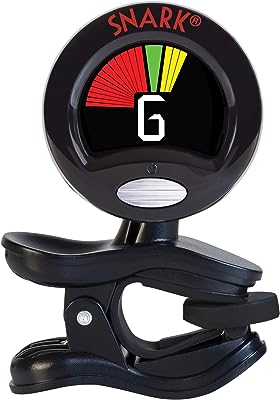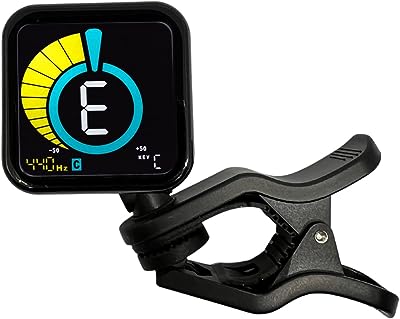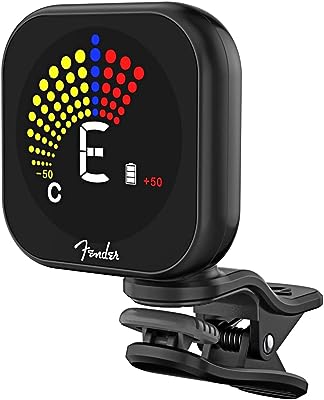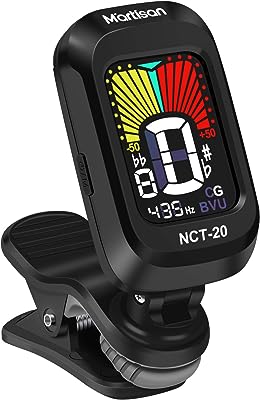Staying in tune is super important when it comes to playing the ukulele. Nothing kills the vibe quicker than a sharp note or a flat chord in the wrong place.
That’s why I think everybody, from the seasoned pros to the weekend jammers, should get themselves a dedicated clip-on tuner that’s accurate, fast and easy to use, without any compromises.
So without further ado, let’s get right into it. Here are some of the best clip-on ukulele tuners on the market today!
6 Best Ukulele Tuners - Top Clip-on Tuners
1. Snark SN6X
The Snark SN6X is probably the highest selling clip-on tuner for ukuleles. Apart from being feature-packed, I also found it to be user-friendly.
As soon as I turned it on, I was blown away by the full color, HD display. It was easy to read and made tuning a piece of cake, flashing green when I was in tune and red when I wasn’t quite there yet.
Unlike other tuners, the Snark SN6X has a clutter-free screen, with just the string pitch and accuracy markers telling me how close I am to being in tune.
While some players will prefer more information, beginners looking for something basic will appreciate the simplicity of this tuner’s interface.
I’d given it to my 9 year old niece to try. She’d recently got her first ukulele (first instrument, really). She had no trouble tuning her instrument with the help of the Snark tuner. She said using this tuner was quicker and easier than using the Android app she’d been using up until that point.
The tuner makes use of a highly sensitive vibration sensor to give you an accurate pitch reading, even in noisy environments. Sometimes even minor touches on the ukulele trigger the tuner, and this hyper-sensitivity might actually irritate some musicians with OCD.
It works flawlessly with guitars too, providing multi-instrumentalists and gigging musicians with a much needed flexibility.
The display sits on an adjustable 360 degree swivel, so I never had to strain my neck to see what tuning I was on.
But what made this tuner stand out to me, was the built-in metronome Snark has included. With just the tap of a button I had an adjustable tapping metronome to play along with which greatly helped me improve my timing on certain tracks.
This tuner clips on to any headstock firmly, thanks to the rubber clamp and is compact and sturdy, so it’ll survive being thrown into a kit bag every now and then.
2. KLIQ UberTuner Max
If you’ve got a couple instruments that could benefit from a clip-on tuner, then the KLIQ UberTuner Max is the way to go.
Not only does it work for ukuleles, but clip it to your bass, acoustic guitar, electric guitar or violin and you’ll never have to worry about being out of tune again.
The tuner uses an advanced microprocessor to give you an accurate pitch reading. Just clip it on, pluck a string and it’ll tell you everything, from the individual octave of the string to how far away from being in tune you are.
The UberTuner Max makes use of a large, full color display with easy to read, precise markers that I could read in the dark and without my glasses on.
The advanced microprocessor means the tuner has a quick response time and the pre-programmed tuning modes means there really are no excuses for playing out of tune anymore.
But what I really love about the KLIQ UberTuner Max is its rechargeable battery. I hate having to carry batteries around with me, so the fact that I can just use a micro-USB cable to keep my tuner working is great. The downside is a hard-to-open battery compartment (in case you ever need to access it).
Now, it’s worth mentioning that this isn't a discreet tuner. It’s big and eye-catching and not a tuner I’d recommend for anyone doing shows who wants a more low-key look.
But for jamming out at home, this tuner is one of the most capable options out there. Probably just not for beginners looking for a basic, compact tuner.
3. Fender Flash 2.0
Fender’s Flash 2.0 clip-on tuner doesn’t deviate from their long-term, hard-earned reputation. A great tool to help keep your ukulele in tune, this tuner is accurate and easy to use without breaking the bank.
The bright and colorful LCD screen made tuning feel easy and guess free, with Fender packing a lot of detail into a relatively small screen.
Dynamic octave markers, battery life indicator and your current tuning mode are always on display, helping you take the guesswork out of tuning up.
I’m also a big fan of the rubberised pivot clip used on the Fender Flash 2.0. It’s sturdy and secure even on my ukulele’s unique headstock shape and it surprisingly kept the paint-job damage free, even after a few weeks of taking it off and on.
You might think it’s a minor thing, but I can recall many instances of my friends and relatives damaging their new ukuleles with a budget tuner made of cheap, hard plastic. It’s easier to scratch the uke neck than you think!
Thanks to the vibration sensor, I was able to get accurate readings even in noisy rooms and on more than one occasion, somebody complimented my tuner for “looking cool”.
If I were to nitpick, I’d say I sometimes faced an 1-2 second lag particularly when tuning the lowest string on my uke. It seems to be just a tad bit slower to detect that string compared to the others.
This tuner comes with a 20 hour battery life, and an auto shut off feature after 10 minutes of inactivity, so I rarely ran out of power. But when I did, I just plugged in a micro-USB cable and was up and running again in no time.
I’d describe the Fender Flash 2.0 as a hassle-free clip-on ukulele tuner, but that’s underselling it. It looks great and works even better. Just make sure to set it to the ‘U’ mode before you try to tune your uke, since there are quite a few modes for other instruments as well (unless you’re going for chromatic tuning).
4. D’Addario Micro
The D’Addario Micro Headstock tuner takes discreet tuning to another level. It isn’t for everyone but, there's a specific type of player that’ll fall in love with this gadget overnight.
Could that be you?
The super small form factor looks like something out of a sci-fi movie and is designed to be tucked away behind the headstock, for your eyes only.
D’Addario uses an extremely accurate piezo transducer to pick up your ukulele’s vibrations, letting you know if you’re out of tune or not, even in noisy settings.
Because of its size the display is pretty basic. No octave readers or battery indicators here; just the string pitch and some accuracy markers for you to tune up with.
Despite that, I was really impressed with just how easy to read the back-lit display was. Using colors to indicate whether or not you're in tune, it's intuitive, accessible and accurate.
Now, they are battery powered (non-rechargeable), which I didn’t love, but the auto-off feature kept the battery life from draining too quickly, so changes were a rare occurrence.
Large rubber buttons on the back help you adjust hertz, screen orientation and toggle power with ease and their size meant even my large fingers could press them with accuracy.
I used the D’Addario Micro Tuner on stage, and even in the low-lit environment I could easily make out and adjust my ukulele’s tuning on the fly.
And the best part… nobody else noticed it.
5. Martisan Clip-on Ukulele Tuner
If you want something that's flexible, compact and doesn’t sacrifice usability, then consider the Martisan clip-on tuner.
Despite being made by a no-name brand, it’s highly accurate. It’s also among the cheapest ukulele tuners out there.
This tuner is great if you need something that’ll cover a wide base. It works on a range of instruments from the guitar, violin, ukulele and even banjo, if that’s your thing.
Left handed or right handed, it doesn’t matter since the large LCD screen can be rotated 360 degrees to find that perfect angle, which isn’t hard thanks to the brightness and clarity of the 1.8 inch screen.
Speaking of screens, I was impressed at just how much information the Martisan clip-on tuner displayed. Accuracy indicators, tuning mode, string name, flat or sharp indicators, this tuner told me everything I needed and more.
All this information can also be its biggest issue for beginners. There are too many things to check and too many buttons to press, so if you’re a beginner it can definitely overwhelm you.
The padded rubber grips were pretty standard and didn’t slip during my testing, and the vibrational pitch sensor was a nice touch helping me keep my ukulele in tune even when things got loud.
Another negative I found about this product is the absence of an auto-off feature. So if it accidentally gets turned on and remains in your gig bag for a long time, it’ll easily drain the battery.
All in all, the Martisan clip-on tuner is pretty compact, accurate and versatile, but might not be the simplest thing to operate for beginners.
How Do I Keep My Ukulele in Tune?
We’d all love it if our ukulele never went out of tune. But that’s just not possible.
Time, use and even the air we breathe are just some of the factors that contribute to our instrument eventually falling out of tune. But what if I told you, there are ways to minimize this?
By being proactive and looking after our ukuleles the right way, we can extend the amount of time between each tuning session, meaning more playing and less knob turning.
Stretch Your Strings
Modern ukulele strings are made from nylon, or a material similar to it, and that means one thing… They stretch.
Just like with a classical guitar, you need to give your uke time to settle and stretch out, especially if you’ve just put on a fresh set of strings. Now, normally this process can take up to 3 days, but I’ll show you a faster way.
Start by putting your ukulele down on its back, with the strings facing up. Holding the body down, grab just one string and gently pull it up, like you’re trying to look underneath it.
Be careful not to snap the string, but make sure you’re putting enough tension on the string to stretch it. Once you’ve let go, you should notice that the string is out of tune.
That’s exactly what you want.
Repeat this process until the string no longer goes out of tune when you pull on it. Do this for all 4 strings and you’re done! You’ll be left with a ukulele that hopefully holds its pitch.
How Hard are You Strumming?

Look, I know it’s fun to wail away on your uke, but that could actually be part of the problem.
You see, even after you’ve stretched all your strings out and given them time to settle, repeated excessive force will cause them to continue stretching little by little.
This slowly brings you and your uke out of tune.
There’s no easy fix for this. Just take it easy on your strings and maybe invest in a ukulele amp if you wanna keep playing that loud.
Check Your Tuners
There are two types of ukulele tuner, and it helps to know which ones you’ve got.
Friction tuners, usually found on older, more vintage ukuleles use a simple tuning mechanism to hold the strings in place. If your uke is struggling to stay in tune check the cardboard washer inside your friction tuner.
It's not unusual for that washer to flatten and stop gripping into the string. This leads to your ukulele being out of tune all the time.
You can either choose to fix it yourself and replace the old tuner or just take it into a repair shop where they’ll be happy to help you out.
If you’ve got a newer uke that uses geared tuners, then check to see if they’ve been installed correctly. Does the tuner shaft pull forward when you tug the strings?
If you’re getting unwanted movement anywhere up in the headstock, that could be a sign something wasn’t installed correctly and tightening it up will help your ukulele stay in tune.
Bag It Up!
When you’re not using your ukulele, it’s worth storing it somewhere dark and dust free to prolong not just your strings’ lifespan, but the ukulele’s as well.
Gig bags, hard cases and even just storing it away in a closet will stop the elements from stretching and weakening the strings, greatly improving the time between re-tunings.
Avoid storing it in places with direct sunlight and try to pick a room with a consistent average temperature and humidity level, as rapid changes in either of those will really damage the wood.
Different Types of Ukulele Tuning
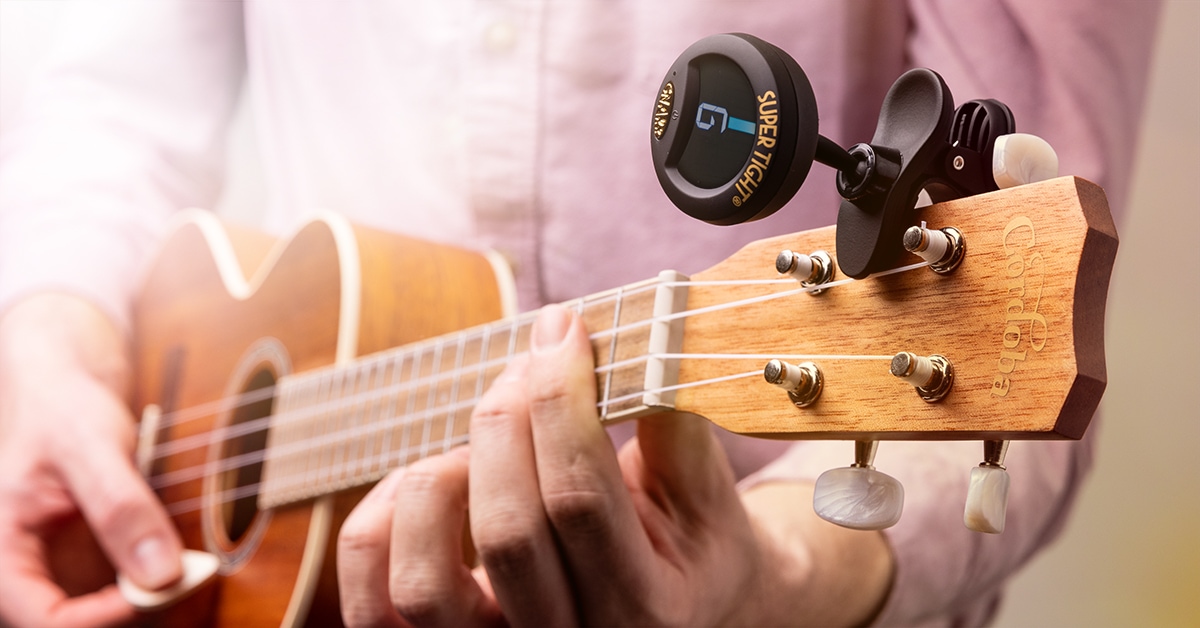
Choosing how you want to tune your uke is going to have the biggest impact on your overall sound.
Standard Tuning
The most common and widely used tuning is G-C-E-A where an open strum would give you a C6 chord. When you think of that Hawaiian, island-y sound, this is usually what they mean.
But there are alternative ways to tune your ukulele. For example:
D-Tuning
Moving a half-step up, you wanna tune your ukulele strings to A-D-F#-B.
This gives it a lighter, more high pitched sound and used to be the standard tuning configuration back in the day.
Low-G Tuning
Usually, the C string is the lowest note on the ukulele, but some players like to tune that top G a whole octave down, turning G into the lowest overall note, like on a traditional guitar.
To do this though, you’ll need a special set of strings that’ll still sound good even though they have less overall tension on them.
One of the most famous ukulele songs ever, “Over the rainbow” was recorded using this tuning method and it’s still a popular choice for concert musicians and amateurs alike.
Slack-Key Tuning
If you’re completely new to the ukulele and you want a tuning setup that’ll let you just play easy, barring chords across the neck, then slack-key tuning is perfect for you.
This method involves taking the A string and detuning, or slacking, it down to a G. This leaves your ukulele with a G-C-E-G tuning.
If you play all the open strings, you get a C chord. Bar your finger over all the 2nd frets and you get a D chord. Move it up 3 more spaces and you have an F chord… you get the picture.
It's easy and sounds great especially if you’re playing anything that’s in the key of C.
The Bottom End
In today's day and age, there really is no excuse for an out of tune ukulele. Clip-on tuners are fast, accurate and so intuitive that even total beginners can figure out how to use them…
I’ve shown you some of the best ukulele tuners out there, and hopefully after reading this it’ll be the first thing you make sure you’ve packed before any session… after your ukulele of course.
Happy playing!


